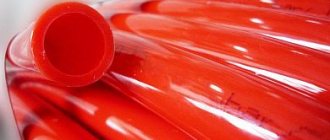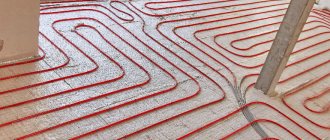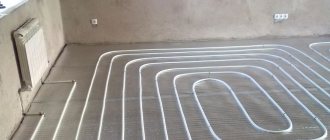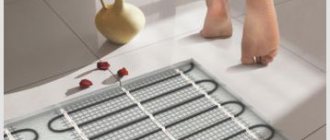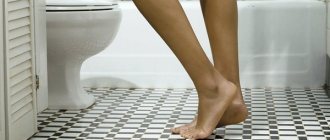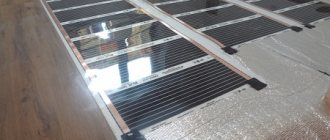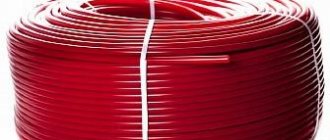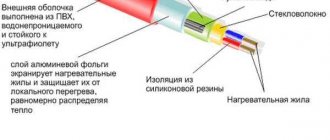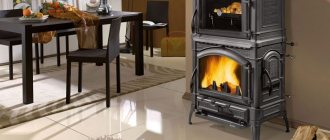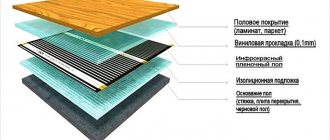A pleasant stay in an apartment or private house is determined, first of all, by the fact that the room should be cozy and comfortable. And this is only possible if the living space is warm. Many people ask the question: what is needed for a heated floor? How to do it yourself, without resorting to the help of specialists? The answers are given in the article.
What you need for a heated floor
Water heated floor in the apartment
Design and principle of operation
Before you start studying information about what materials you may need to install a heated floor yourself, you should understand what the operating principle of this system is. So, a warm floor is a system of small diameter pipes assembled and laid in a certain way, inside which a coolant supplied by a pump is located and circulates. The heat carrier is ordinary water, heated in a special device. During installation, the pipes are laid under the floor covering or directly into the screed, depending on the installation method.
Operating principle of water heated floor
Expert opinion
Afanasyev E.V.
Chief editor of the pol-exp.com project Engineer.
To make it pleasant to walk on the floor barefoot, the temperature of the coolant should not be high - no more than +40-45 degrees. In this case, the floor covering itself will warm up to only +25-28 degrees. However, heating equipment usually warms up the water more strongly - up to +60-65 degrees.
Connection diagram for a water heated floor boiler
That is why it is necessary to regulate the temperature of the coolant. In the cottage, a condensing gas boiler will help ensure the ability to adjust, which is highly efficient even at low temperatures. Here the water will be immediately supplied to the heating system. For some other types of boilers, it is necessary to use a specially designed mixing unit, thanks to which cooled water will be supplied to the heated water.
Traditional radiator heating
Traditional radiator heating
Next, the water begins to be distributed along the heating circuit using a distribution comb - a pipe branching system. It is also called a collector. It consists of two pipes - supply and return - which supply and collect water from the branches of the system.
On a note! The distribution manifold may be absent if the heated floor is installed in a room with small dimensions.
Warm floor collector
Disadvantages of heated floors
Unfortunately, in multi-storey buildings built decades ago, it will be quite difficult to install warm water half-water - such apartments (or rather, the heating system in them) are simply not suitable for this technological solution. If such a floor is installed, then in winter the neighbors will complain about the cold in the apartment. And the homeowner is unlikely to be satisfied with the temperature readings at home. The management company will also most likely not give permission to install heated floors. In this case, it is best to install electric floor heating - it does not require a permit.
Electric heated floor
On a note! In new buildings now, as a rule, a special heating system is installed, which allows you to connect heated floors to it. In such buildings you don’t even have to ask permission from housing and communal services for installation.
Materials for electric heated floors
Electric cable underfloor heating is most often used. It is based on a grid of cables laid in the correct order. They must be laid around the entire perimeter.
The cable system must be selected very carefully and carefully, the sheath must be dense, there must be no flammable material, there must be resistance to melting and mechanical damage, this will help to avoid accidents.
There are two types of cables: they can be single-core or double-core. It is better, of course, to opt for the second option, since it has greater resistance; the cable also emits a small amount of infrared radiation, which is also harmful to human health and life.
You can use another type of warm fabric, which is laid using film. It is laid on the floor covering. The main advantage is that there is no need to raise the floors, and there is also a big saving on labor, because you can carry out all the work yourself.
Recently, thermomats have become increasingly used. The essence of such mats is that a heating element called a carbon rod is used, it is attached to the film. No additional sacrifices will be required, for example, you will not have to reduce the height of the room.
The flooring will be mounted directly onto the mat itself using glue. In total, electric heated floors may require:
- heating elements such as cables or mats;
- thermal insulation material;
- material for leveling, you can use foil;
- thermostat;
- temperature sensor;
- you need to use a corrugated pipe;
- electrical wire
Everyone can choose which material to choose for an electric floor based on their budget, which is why materials cost differently.
We recommend: How to lay heated floors over wooden joists?
Materials for heated floors
The diagram of such a floor in the picture always looks quite complex - a mass of communications connected to each other, through which water also flows. However, in reality the system does not include such an extensive list of elements.
Materials for water heated floors
Accessories for water heated floors:
- if it is not possible to connect to the centralized heating system, use a heating boiler ;
- pump , which is either built into the boiler or purchased separately. It will pump water into the system;
- directly the pipes through which the coolant will move;
- collector , which will be responsible for distributing water through pipes (not always necessary);
- the collectors will need a special cabinet, splitters that distribute cold and hot water, as well as valves, an emergency drain system , and devices for removing air from the system ;
- fittings, ball valves , etc.
One of the options for a heating scheme in a private house with heated floors on the ground floor
Also, to install a heated floor, you will need thermal insulation material, fasteners, reinforcing mesh, and damper tape. If the raw installation method is performed, then also the concrete mixture from which the screed will be made.
Fastenings for water heated floor pipes
Mounting strip for heated floors
The choice of materials and tools for the floor heating system will often depend on the installation method. There are two types of equipment laying - dry and wet.
- Wet technology involves the use of insulation, fastening systems, pipes, and concrete screed. After all the elements have been filled with screed, the floor covering itself is laid on top. A damper tape must be laid around the perimeter of the room. It is advisable to place a waterproofing layer under the insulation in case of water leakage - it will protect neighbors from a possible flood.
Water heated floors. Water floor diagram
- Dry technology. In this case, the heating system is placed on wooden plates or polystyrene mats in specially made channels. Sheets of plywood or gypsum fiber board are laid on top of the system. The flooring is installed on top. By the way, you should not lay chipboard or OSB on top of the system, since they contain substances that, under the influence of elevated temperatures, begin to evaporate and negatively affect the human body.
Warm floor without screed
Neither the first nor the second methods are ideal - each has its own advantages and disadvantages. However, most often the wet method is used, when the underfloor heating system is laid in a screed. The reason is simple - low cost, although this type is quite difficult to maintain. For example, repairing pipes in a screed will not be easy.
Screed for heated floors
Distribution manifold and cabinet for it
It makes sense to install the distribution comb or manifold inside a cabinet specially designed for this purpose, so that the mass of pipes is not noticeable and does not spoil the appearance of the room. The width of such a structure should be about 12-15 cm, but other parameters will largely depend on the dimensions of the entire communication system - the larger it is, the larger the cabinet. When arranging it, the need for space for bending pipes supplied to the collector system must also be taken into account.
Collector in a niche
Important! If the underfloor heating system is divided into two rooms, then the box with the collector should be located in the middle between them. In this case, it is better to install equipment that allows you to regulate the heating temperature.
manifold for underfloor heating
Pipes
Pipes in a heated floor system are the most important element. After all, it is along them that the heated water will move. They need to be chosen correctly.
Choosing pipes for heated floors
Table. Types of pipes for heated floors.
| View | Description |
| Copper | Very good, but also very expensive looking. It is ideal for installing a heated floor, but the pipes themselves and the components for them are very expensive. The heated floor system is reliable, capable of withstanding almost any load and very high heating temperatures, and does not burst when overcooled. |
| RE-X or cross-linked polyethylene | Often found pipes are quite durable and can withstand heating up to +125 degrees. When water flows through them, it is practically inaudible due to the high sound absorption rate of the material. Elastic and pleasant material. |
| Metal-plastic | Consists of 3-5 layers, which are connected to each other with special glue. The center of the pipe is foil-coated, thereby increasing the thermal conductivity of the material. The pipes bend well. |
Polypropylene | A cheap option, which is almost never used for installing heated floors, as it bends poorly. It will not be possible to lay it with the required step, and its thermal conductivity is poor. |
Aluminum pipes for heated floors - another possible option
Copper pipes have many advantages
Advice! It is best to purchase pipes made of cross-linked polyethylene - this is the optimal price-quality ratio.
pipes for heated floors
The recommended diameter of pipes for heated floors is 16-20 mm. In this case, the material must withstand heating up to +95 degrees and pressure up to 10 Bar.
KAN-therm pipes for heated floors
There are different pipe laying schemes, but the most commonly used are snake, double snake and snail-spiral. The first is simple to implement, but as the coolant passes through the circuit, it has time to cool significantly. In this case, installation is carried out from a cold zone to a warm one - for example, from a window to a wall. Spiral and double snake are more difficult to install, but more effective in terms of heating.
How to make a water heated floor - installation diagrams
Styling tips
- The contour should always start only from the coldest wall - from an external load-bearing one or one equipped with a window.
- If the room does not have a common wall with the street, then the system can be laid from the edges of the room to its center.
- The snake will provide gradual heating of the floor.
The pitch of laying the pipe system is usually about 10-30 cm: where heat losses are high, the pitch should be 15 cm, and where they are normal or minimal - 30 cm.
Installation sequence for a heated water floor
The number of pipes will have to be calculated individually for each room. This takes into account the dimensions of the room, the pitch between the pipes, the power of the boiler, the cross-section of the pipe and a host of other small nuances.
Pipe laying
Advice! The easiest, fastest and most accurate way to calculate the number of pipes is using special computer programs.
If an error is made in the calculations, various problems may subsequently arise:
- poor water circulation;
- “thermal zebra” effect - alternating warm and cold areas on the floor;
- heat leak.
Warm floor
Heated floor pipe circuit length calculator
Go to calculations
Material calculation
The calculation of the material should be done taking into account all the issues that may arise during installation, for example, it is important to remember that there can be a dry screed, or it can be “wet”. Also, pipes and wires can be laid in a snake, snail, double spiral, loop, and this is a completely different material consumption.
- Related Posts
- How are pipes for underfloor heating made of cross-linked polyethylene laid?
- How to install electric heated floors under tiles?
- Is it possible to lay laminate flooring on a heated floor?
- How to lay a heated floor under PVC?
- What materials are suitable for waterproofing underfloor heating?
- What is a mobile heated floor?
Fasteners for heated floors
If heated floors operating on the basis of electricity are quite simple to install - cable or roll heaters are simply attached with ordinary tape under the level of the floor covering - then the system for fastening a heated floor on water is more complicated.
Methods for attaching underfloor heating pipes
The coolant system can be secured:
- using a grid, to which the pipes are attached with wire or clamps. The step between the rods is 5 cm;
Fastening pipes using mounting mesh and plastic clamps
- using fasteners , which are used together with the thermal insulation layer. The clamps are attached to the subfloor according to a pre-designed pipe laying pattern;
- mounting tape, polymer or metal . In the first case there are special grips, in the second there are petals that bend and then wrap around the pipe;
- in expanded polystyrene slabs or heated floor mats in which the retainers are already formed. The most expensive fastening method. But this method allows you to combine the thermal insulation layer with the fastening system.
The cheapest option is reinforcing mesh, and the most expensive is polystyrene foam.
Installation of a pipe system for heated floors (without screed)
Rack type installation of water heated floor
Water heated floor pipes: what they can be
The peculiarity of water floor heating is that the pipes are usually walled up in the screed. That is, in order to replace them (due to old age) or eliminate a leak, you will have to break the concrete. First, of course, you need to remove the final finishing of the floor, and then pick up the concrete. A sad prospect. To avoid this, all pipes for heated floors are, first of all, considered from the point of view of reliability and durability. It is also important that they bend well, since they have to be laid according to a certain pattern in which there are bends.
You will need a lot of pipes for a water heated floor.
Also, the material of pipes for heated floors should not allow oxygen to pass through. Otherwise, it will oxidize the metal components of the heating system. Well, the walls must be strong enough to withstand the constant pressure of the screed. What is also important is the price. A lot of pipes are required (more than a hundred meters for a small room), so the price is important. But the priority is reliability and durability. As you can see, there are a lot of requirements, but there is plenty to choose from.
Metal-plastic pipes
This is a combined type of pipe. Metal foil is embedded in a layer of plastic. The pipe turns out to be quite flexible (minimum bend of 8 radii), and does not allow much oxygen to pass through. But:
- Service life is about 20 years. And this is subject to operating conditions.
- The price is quite high. You can save money if you lay pipes without connecting the pieces - fittings are expensive.
- Lots of fakes.
Only those reinforced with aluminum are placed in the screed.
MP pipes are produced in the form of coils. The most common length is 20-30 meters, but you can also find a length of 60-70 meters “to order”. A dozen years ago this was a fairly popular option, but today there is a pipe for the same (approximately) price, but with better characteristics.
Polypropylene - not very comfortable
Only reinforced polypropylene pipes can be laid in screeds. Others simply cannot withstand such a load. This means that they hardly bend. They are cut at the bend points and fittings are installed, but connections in the screed are dangerous. There is another option. Choose a pattern with a small number of turns and bend the pipe after heating it. This way it can be bent, but the bending radius will be at least 8 diameters, which is quite a lot.
Too many connections. Pouring into a screed is risky
The advantages of using polypropylene pipes for heated floors are that they are durable, not too expensive, and can be frozen several times. But the mechanical strength is not too high, so the minimum screed above the surface of the pipe is 5 cm. Taking into account the fact that the walls of the PP pipe are also considerable, the total concrete layer will be at least 7 cm. And this means an increased load on the floor, and additional costs to the solution. In general, this type of pipe is of little use for a warm water floor.
Copper pipes for heated floors
Copper is reliable, does not allow oxygen to pass through, and bends well. Coils can be several tens of meters long, which reduces the number of welds. In principle, you can do without them, but the collection group will be large (and expensive).
Elements of a warm water floor: copper pipe - it is better not to pour it into the screed
The disadvantages of using copper pipe include cost and galvanic corrosion that occurs if copper is left in a layer of concrete. Everything is clear about the cost. Copper is expensive. Corrosion is a process that results in the corrosion of pipe walls. Therefore, copper is usually not poured into the screed. This pipe is used in a “dry” water floor. This is if the pipes are laid in special plates, and a plank floor is laid on top. Copper is ideal for this. It gives off heat well. Best of all polymers. So when using a dry floor heating system, it is advisable to splurge on copper pipes.
Cross-linked polyethylene: PEX and PERT
For heated floors, specially treated polyethylene is used - cross-linked. Cross-linking refers to a special treatment of this polymer, which results in increased strength and the ability to withstand high temperatures.
PEX pipes
For heated floors, it is recommended to use cross-linked polyethylene such as PEXa, PEXb PEXc. PEXa is preferable because it has more stable characteristics.
This is what a cross-linked polyethylene pipe usually looks like
In general, they are good: inexpensive, flexible, durable. However, it is worth remembering that the material is elastic. The minimum bending radius is small - 3-4 diameters. But in order to hold the pipe, it must be tied very well. That is, installation is not the easiest. But at any speed of movement of the coolant, such a warm floor does not make noise (which can happen with copper and polypropylene pipes). And the price is no more expensive than metal-plastic.
PERT pipes
There is another type of polyethylene pipe for underfloor heating - PERT. It differs from PEX in that additives are introduced into the source material to improve strength and increase resistance to temperature. The pipe itself is cheaper, the characteristics are more stable. But only on condition that the coolant is no warmer than 70°C. From this temperature a sharp loss of properties begins. For heated floors this is not critical, because the temperature of the coolant should not be higher than 50°C. Although it is controlled automatically, malfunctions occur with it.
Table for comparing different types of cross-linked polyethylene pipes
So if the choice is between PEX and PERT, the first one makes sense to use in conjunction with boilers that are not very automated. These are wood and coal. Due to its features, the outlet temperature is more difficult to control. PEX pipe can withstand overheating (up to 110°C) for short periods of time without consequences. PERT rapidly ages and deteriorates. Therefore, it makes sense to use this type of pipe in systems with automated boilers.
The disadvantages of cross-linked polyethylene pipes include large linear expansion when heated (1000 mm per 100 meters of pipe). Filled in the screed, they cannot escape anywhere. They can only shrink. And this reduces the pipe clearance and increases hydraulic resistance. To avoid this, the screed is poured when the polyethylene pipes are under excess pressure. It is 30-50% higher than the worker. This is a test of strength, and the pipes will be partially elongated. So when heated they will not shrink as much.
How to fasten
Small but important components for a warm water floor are pipe fasteners. Correctly chosen, it speeds up installation. At the same time, the quality of fixation does not suffer. Here's what you can use to secure water floor pipes:
Types of pipe fasteners
- Plastic clamps to metal reinforcing mesh.
- Special plastic staples for expanded polystyrene (EPS).
- Using metal plates for fixation, which are attached to the primary screed or insulation in increments of 20-40 cm.
- If you need insulation under a warm floor, you can buy mats with bosses. These are protrusions cast on the surface with which the pipe is held.
These are the main methods of attaching a heated floor pipe. The most economical one is to attach it to the mesh using ties. Ties can be replaced with wire, but it will only be cheaper if you have free wire.
Thermal insulation for heated floors
Thermal insulation is an important element when installing heated floors. It will avoid heat loss and increase the efficiency of the system. It is laid on the floor itself, and a damper tape is also installed along the walls, which will compensate for the thermal expansion of the screed and reduce heat loss.
Thermal insulation for underfloor heating pipes
Advice! It is advisable to lay a heat-reflecting layer - thanks to it, the heat directed downward will be reflected and returned upward.
The thickness of the thermal insulation layer will mainly depend on how well the subfloor is insulated. For example, if there is a heated room below the floor, then a layer thickness of only 1-2 cm is sufficient. If the housing is located on the ground floor or above an unheated room, then the thermal insulation layer should be at least 5-10 cm, especially in the northern regions of the country.
Screed device for heated floors
Insulation for heated floors
Thermal insulation for underfloor heating is important. If the floors are warm underneath themselves, then you can use a small layer of 20 mm for insulation; if they are cold, then no less than 50 mm.
In the northern regions, 100 mm thick insulation is generally used. For any type of heated floor, the following insulation is suitable:
- polystyrene foam in rolls and slabs. It is distinguished by its high thermal conductivity and has a wide temperature range of use. Such material is not susceptible to damage by bacteria;
- cork covering is used in a roll or as slab insulation. Has excellent thermal insulation properties. But, unfortunately, this material also has disadvantages: it is not advisable to use the material in rooms with high humidity, it rots easily, and bacteria multiply well in it. Cork is considered a natural covering;
- mineral wool. This material can be produced as mats and rolls. Of course, it is more suitable for insulating ceilings and walls. The big disadvantage is that it is highly hygroscopic, that is, when the material gets wet, it simply loses all its properties. As soon as the mineral wool begins to dry out, the properties are restored, but not completely. If you lay mineral wool insulation in a screed, then under the weight it can close, and the thermal insulation properties accordingly deteriorate;
- Expanded polystyrene is used much more often as insulation. This is exactly the material that can satisfy all requirements. The most important thing is that it is easy to install; it comes in the form of slabs that have special locks for connection.
We recommend: How to install heated floors under porcelain stoneware?
How to make a water heated floor
Making a simple water heated floor in a small room is quite simple even without the help of specialists. The technology for laying a water floor is as follows.
Step 1. The base is prepared - a thin layer of sand is poured onto the subfloor, compacted and leveled.
Preparing the base
Step 2. A layer of waterproofing material is laid - for example, polyethylene construction film.
Laying polyethylene film
Step 3. A thermal insulation layer is laid on top - polystyrene foam 5 cm thick. If necessary, the material is cut to the required size.
Laying polystyrene foam
Step 4. A damper tape is attached around the perimeter of the room.
Attaching the damper tape
Step 5. Reinforcing mesh is laid.
Laying reinforcing mesh
Step 6. According to the chosen scheme, a pipe is laid through which the coolant water will flow.
Laying a water heated floor pipe
All is ready
Step 7. The pipe is secured using plastic clamps.
Plastic clamps
Step 8. The supply and return are removed from the system.
Exiting supply and return from the system
Step 9. Next, work is carried out on laying the cement screed and leveling it.
Cement screed device
Attention! It is worth remembering that the concrete layer above the heated floor system must be at least 3 cm. In this case, the screed should be poured after filling the system with water.
A thermostatic column for underfloor heating is installed on the “return”, which will regulate the temperature of the water in it (“return”). The work is completed by connecting the system to the heating. It will be possible to use a heated floor after laying it using the wet method only after the concrete has dried thoroughly. The approximate period is 28-30 days.
Video - Laying a warm water floor
Water floor materials
Installing a water floor is quite simple; pipes are laid in the concrete base, through which hot water will then flow; we must remember that it should not be higher than 50 degrees.
This heating method transfers all its heat to the floor covering, thereby creating a favorable indoor climate. Let's consider all the materials for a warm water floor:
- First of all, pipes in diameter may be required; they should be 16-20 mm. The material of the pipes can be very diverse, for example, polyethylene, metal-plastic or even copper pipes are suitable. The most in demand and popular are polyethylene pipes. This material has proven itself to be the lightest and most durable. The main advantage is that leaks are rare, the material is resistant to chemicals and is durable even under high loads;
- You will also need a collector to lay the water floor;
- It is impossible to lay a water-based warm floor without damping tape and waterproofing film;
- To enhance heat, it is imperative to use thermal insulation material, for example, polystyrene foam or mineral wool;
- A reinforced mesh and stands for it will be an excellent assistant;
- In addition, wire and clamps are needed when laying such a warm floor.
We recommend: How are PEX pipes connected for heated floors?
When choosing materials for water heated floors, you must not forget about the control system; it allows you to set the desired temperature regime and significantly reduce the amount of energy for heating water.
